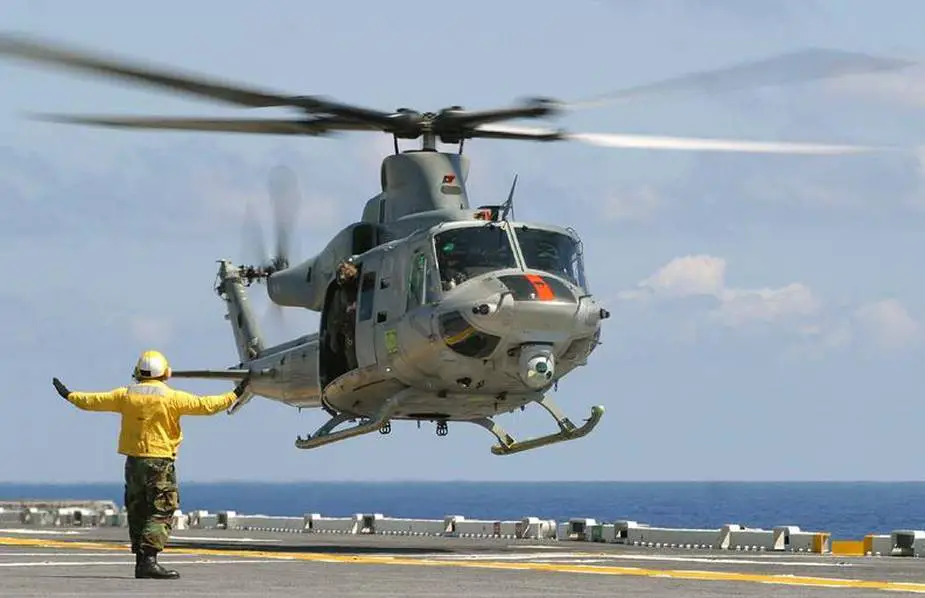Members of the U.S. Marine Light Attack Helicopter Training Squadron (HMLAT) 303 and the H-1 Light/Attack helicopters program office (PMA-276), recognized a group of airmen from the Czech Republic Air Force during a ceremony on Feb. 9 for completing maintenance and flight training on the H-1 family of the aircraft.
Follow Air Recognition on Google News at this link
 AH-1Z Viper attack helicopter (Picture source: Bell)
AH-1Z Viper attack helicopter (Picture source: Bell)
The Czech students have been embedded with the HMLAT-303 since July 2022, taking the same courses and hands-on training utilized by the U.S. Marine Corps' military occupational specialties (MOS) for the AH-1Z Viper and UH-1Y Venom. The syllabus is designed to provide the initial knowledge, skills, and experience required to maintain, operate, and fly the H-1 platform.
"The training we did with the Czechs provided the foundational knowledge to fly and maintain these machines [AH-1Zand UH-1Y]," said Lt. Col. Mark Koval, Commanding Officer, HMLAT-303. "They now have the basic skills to transition to tactical training with their own fleet of helicopters."
In 2019, the Czech Republic selected the H-1, specifically four AH-1Z and eight UH-1Y aircraft, to modernize the country's armed forces and strengthen its homeland defense. As part of the foreign military sales contract, the customer had the opportunity to send its first wave of H-1 aircrew and maintainers through the HMLAT-303 training pipeline, preparing them for aircraft deliveries throughout 2023.
The training syllabus included familiarization, navigation, ordnance, formation, night vision goggle, terrain and instrument training. In addition, maintenance students completed training with the Center for Naval Aviation Technician Training Detachment Camp Pendleton, Ca.
"This training is part of our larger efforts to ensure the Czech Republic Air Force has all of the tools and resources required to fly its new aircraft for decades to come," said Col. Vasilios Pappas, PMA-276 program manager.
Once back in country, the H-1 crew will continue training, working with representatives from the H-1 original equipment manufacturer, Bell, and their supplier, Pinnacle Solutions. Based on a "train-the-trainer" model, pilots, crew chiefs and maintainers will learn the final skills required to operate and sustain its fleet of AH-1Z and UH-1Y helicopters, and train other members of its force.
The Czech Air Force squadron is expected to be independently operating in late-2024.
"We are committed to the success of our customer in their deployment of the H-1 platform and grateful to HMLAT-303for their role in that success story," said Pappas.
PMA-276 manages the end-to-end procurement, development, support, fielding and disposal of the Marine Corps rotary wing close air support, anti-armor, armed escort, armed/visual reconnaissance and fire support program systems.
AH-1Z Viper
The roles of the U.S. Marine Corps: Close Air Support, Armed Escort/Reconnaissance, Anti-Armor Operations, Control of Supporting Arms, Anti-Air Warfare.
The United States Marine Corps (USMC) replaced the two-bladed AH-1W Super Cobra with the AH-1Z Viper, which features a new, four-bladed composite rotor system, performance-matched transmission, four-bladed tail rotor, upgraded landing gear and a fully integrated glass cockpit. The AH-1Z is equipped with an integrated advanced fire control system and the capacity to support multiple weapons configurations.
Specifications
Fuselage Length: 44 feet, 10 inches
Overall Length: 58 feet, 3 inches
Height: 14 feet, 4 inches
Weight: 12,300 lbs (empty), 18,500 lbs (max gross)
Max Useful Load: 5,764 lbs
Max Internal Fuel: 2,858 lbs
Payload (Hot Day): 3,179 lbs
Max Endurance: 3.3 hrs
Power Plant: 2 General Electric T700-GE-401C turboshaft engines
Sensor: Advanced Third Generation FLIR – Lockheed Martin, Target Sight System (TSS)
Weapons Stations: 6 Wing Stores (4 Universal, 16 PGM’s)
Crew: Two; pilot, co-pilot/gunner
Contractor: Bell Helicopter Company
 AH-1Z Viper attack helicopter (Picture source: Bell)
AH-1Z Viper attack helicopter (Picture source: Bell)
UH-1Y Venom
The UH-1Y Venom replaced the UH-1N Huey and includes the latest in technology and production techniques to continue the legacy of the venerable and battle-proven H-1 helicopter design. The UH-1Y includes a new four-bladed, all-composite and ballistically tolerant (up to 23 mm) rotor system, new engines and transmissions, an integrated digital cockpit featuring multifunction flat panel displays, increased payload capabilities, and crash-worthy seating for all crew and passengers. The UH-1Y Venom platform also provides a significantly increased load-carrying ability, greater range and survivability, and has a smaller logistics footprint. Additionally, the AH-1Z and UH-1Y share 85 percent parts commonality, designed to significantly reduce life-cycle costs and the aircraft’s logistical footprint, while increasing the maintainability and deployability.
The UH-1Y is the most significant upgrade ever made to the venerable and battle-proven H-1 helicopter. At the heart of the upgrade is a new four-bladed, all-composite and ballistically tolerant (up to 23 mm) rotor system. Upgraded engines and transmissions, integrated digital cockpit featuring multifunction flat panel displays, increased payload capabilities, crash-worthy seating for all crew and passengers, and 85 percent common parts with the AH-1Z Super Cobra. The UH-1Y platform also provides increased load-carrying ability, greater range and survivability, and has a smaller logistical footprint.
Specifications
Primary Function: Utility helicopter
Contractor: Bell Helicopter Company
Date Deployed: Initial operating capability 2008
Propulsion: Two General Electric T-700-GE-401C Turboshaft engines, 1,800 shp (1,340 kW) each
Length: 58 feet, 4 inches (17.78 meters)
Height: 14 feet, 7 inches (4.5 meters)
Rotor Diameter: 48 feet, 10 inches (14.88 meters)
Weight: Empty: 11,840 pounds (5,370 kg); Maximum Takeoff Weight: 18,500 pounds (8,390 kg)
Crew: Twelve; pilot and co-pilot, one crew chief, one gunner and eight combat-equipped Marines
















